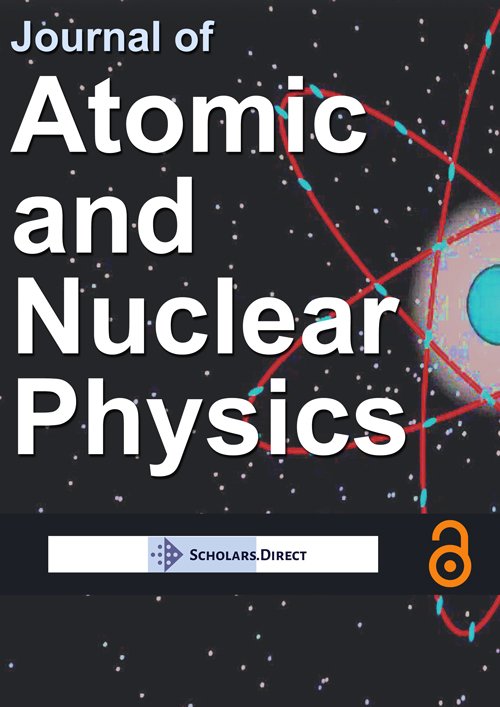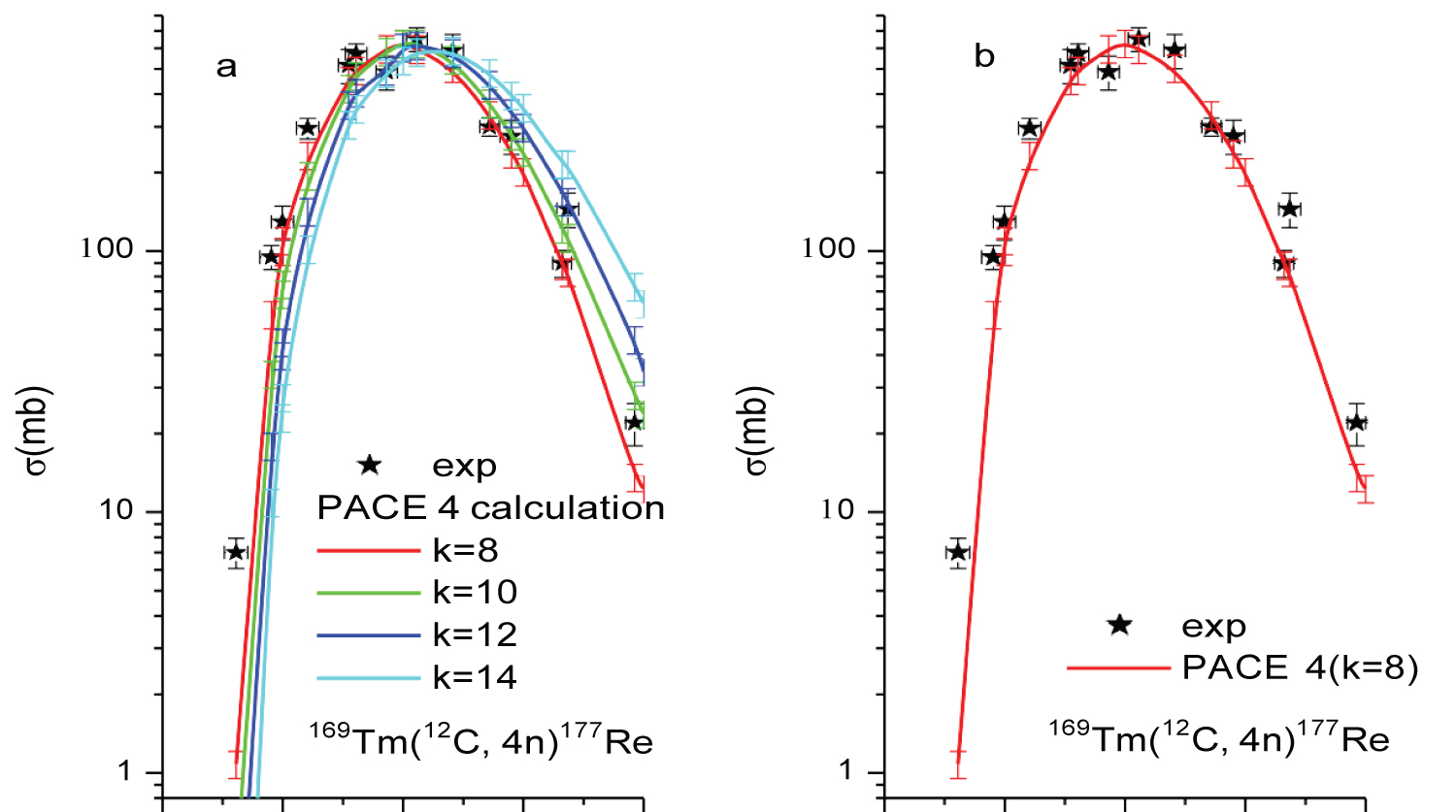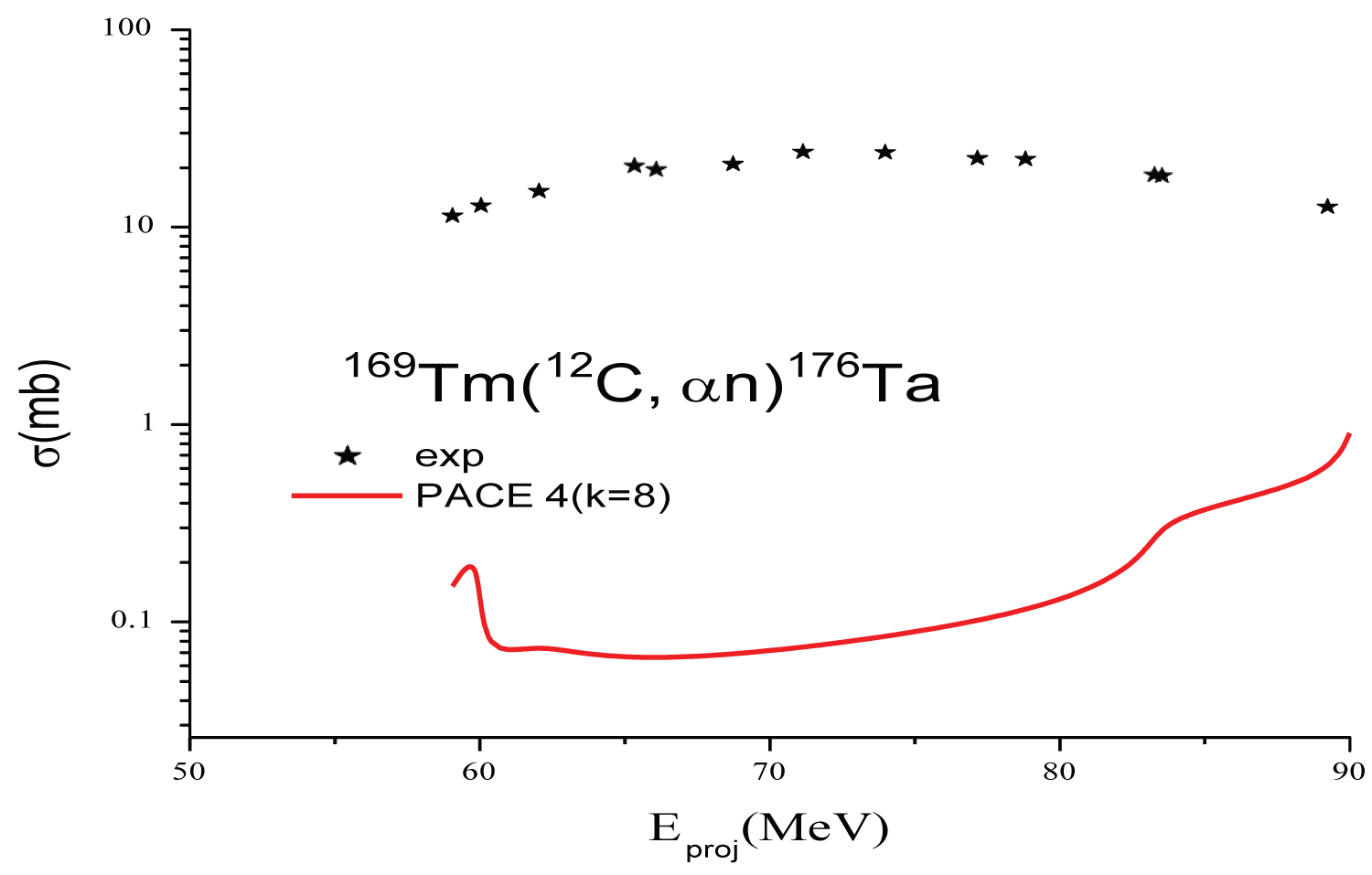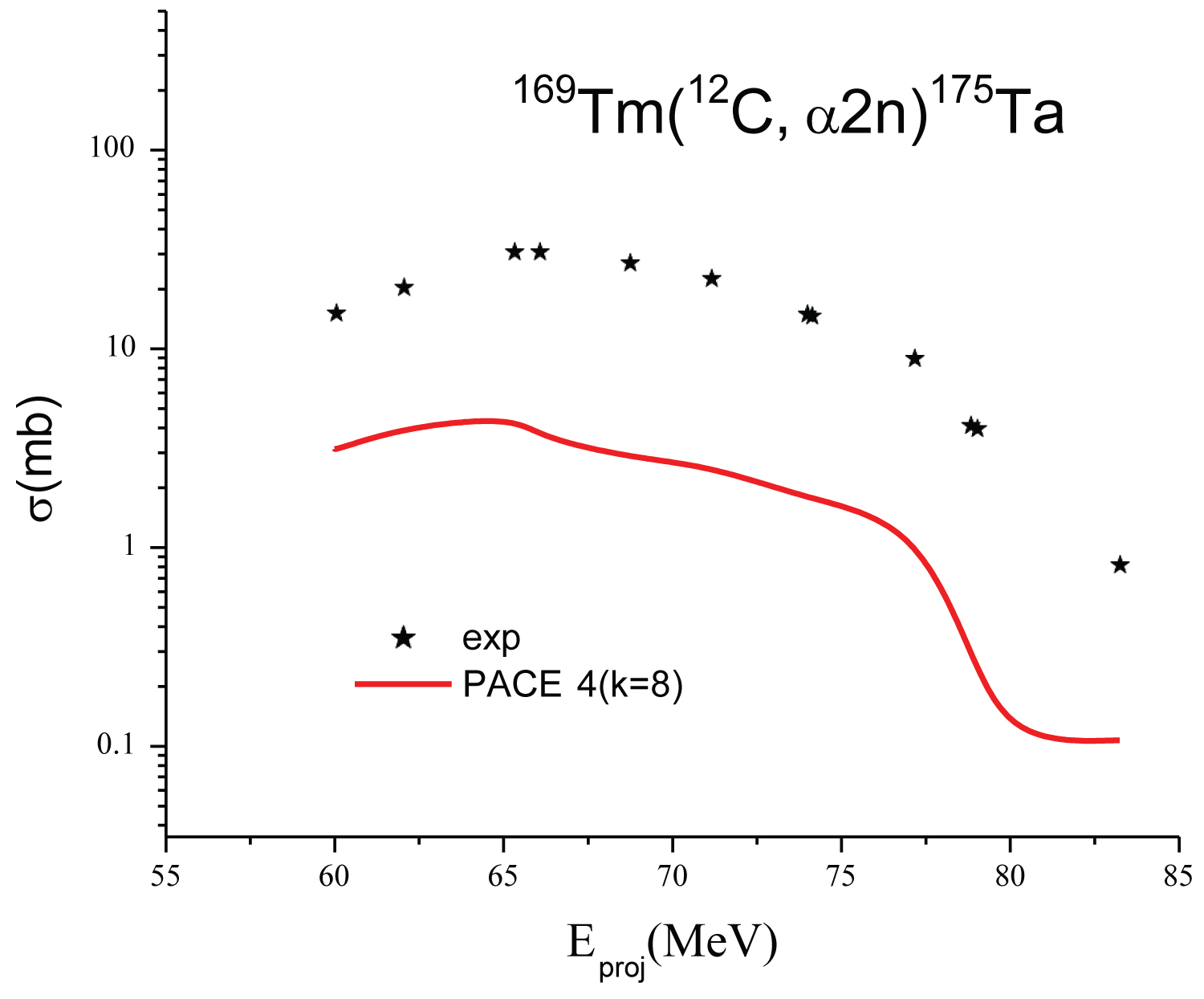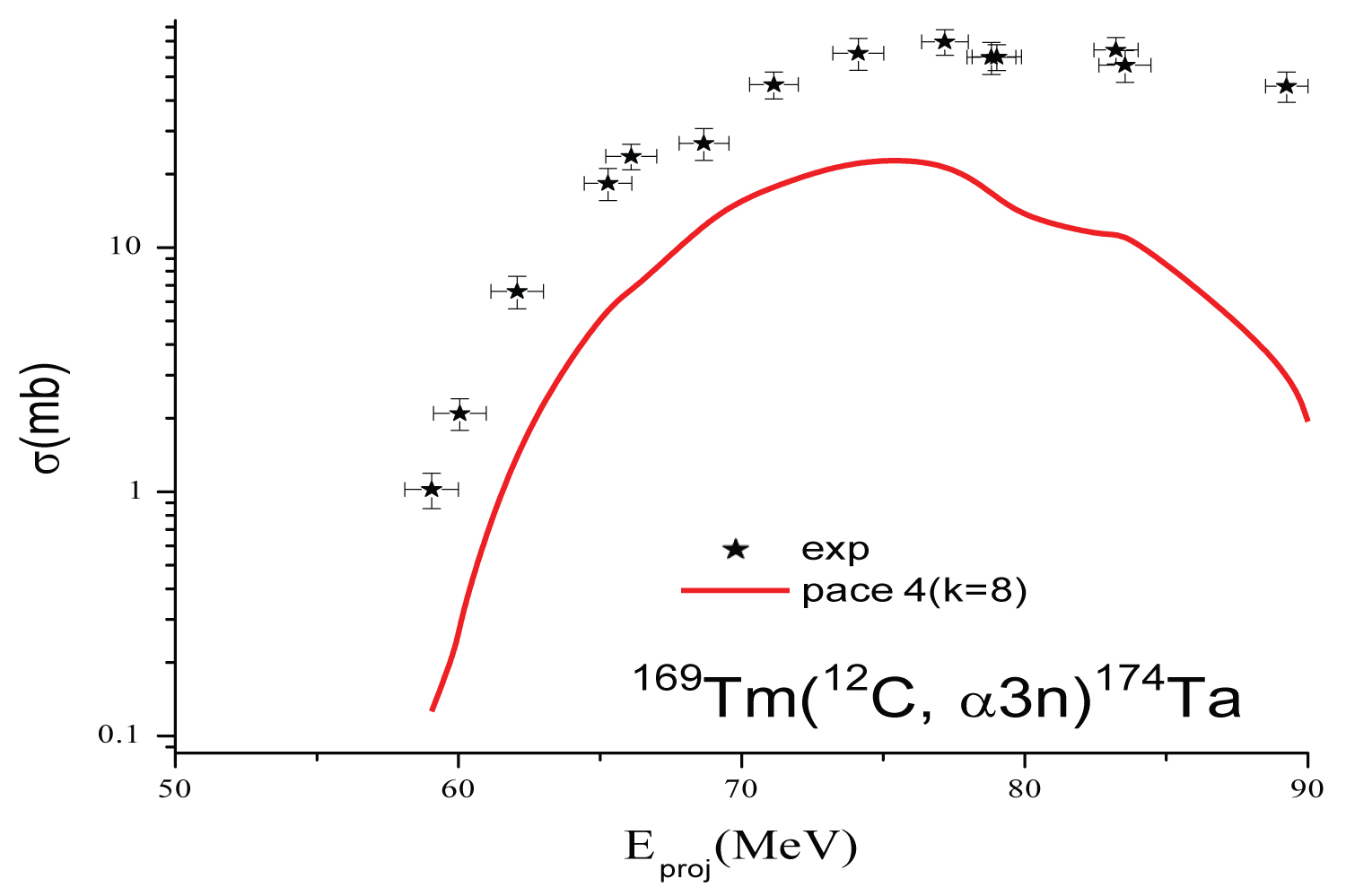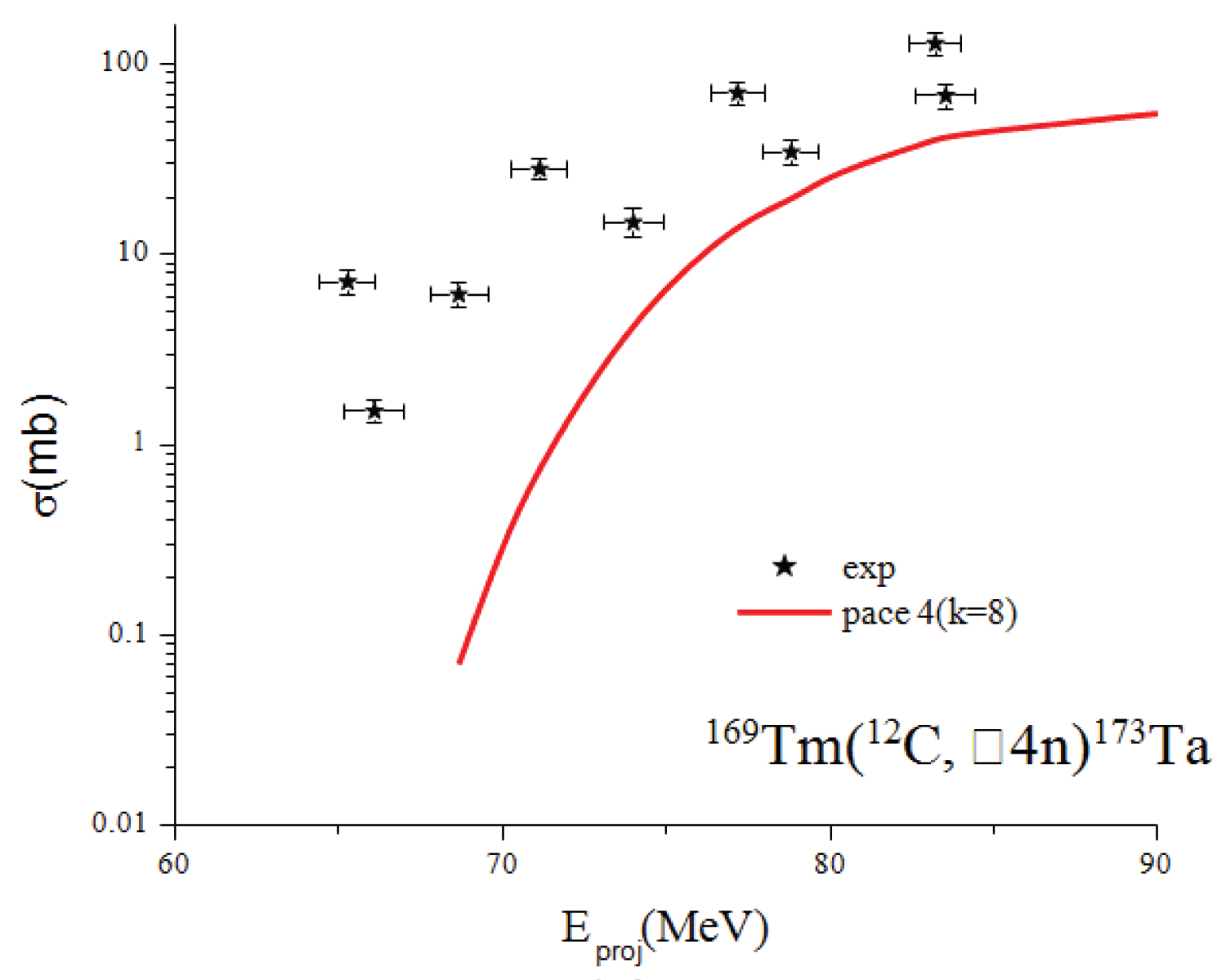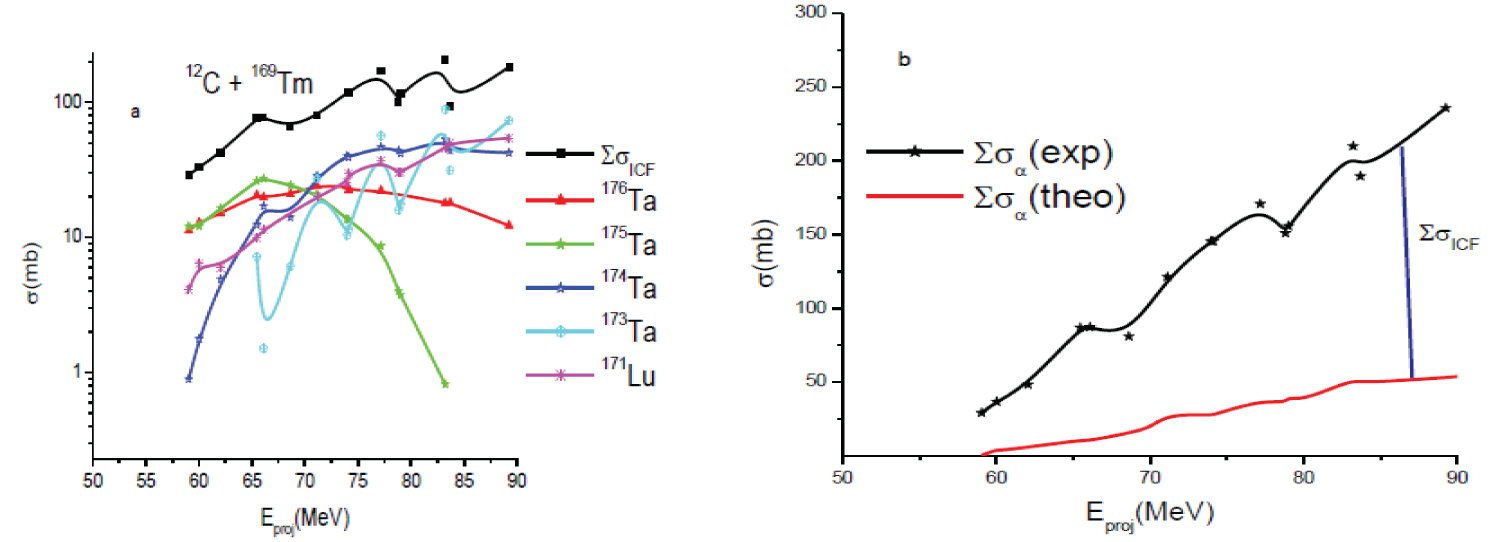A Study of Complete and Incomplete Reactions of 12C + 169Tm System at Energy Range ≈ 4.16-7.5 Mev/Nucleon
Abstract
In this paper, an attempt was to measure the excitation functions of 169 Tm( 12 C, 4n) 177 Re, 169 Tm( 12 C, 5n) 176 Re, 169 Tm( 12 C, αn) 176 Ta, 169 Tm( 12 C, α2n) 175 Ta, 169 Tm( 12 C, α3n) 174 Ta, 169 Tm( 12 C, α4n) 173 Ta and 169 Tm( 12 C, 2α2n) 171 Lu reaction channels populated in the interaction of 12 C projectile with 169 Tm target were considered in order to investigate the mechanisms of complete and incomplete fusion reactions. The theoretically predicted excitation functions using PACE4 code were compared with the previously measured excitation functions. For non–α emitting channels cross-section values predicted by PACE4 in general were found to be in good agreement with the experimentally measured values. However, for α-emitting channels, the measured cross-section values were found to be higher than the values predicted by PACE4. The observed disagreement may be credited to projectile break-up in the vicinity of n-n interaction.
Keywords
Alpha emitted, CF reaction, Excitation functions, Heavy-ion fusion, ICF reaction, Non-alpha emitted
Introduction
Most nuclear reactions are studied by inducing a collision between two nuclei (nucleon- nucleon reaction) where one of the reacting nuclei is at rest (the target nucleus) while the other nucleus (the projectile nucleus) is in motion. Projectiles heavier than α-particle (i.e. A ≥ 4) are commonly regarded as heavy ions and become used for bombarding the target nuclei.
It is now generally recognized that several reaction mechanisms are operative in heavy ion-induced reactions below 10 MeV/nucleon. In fact the cluster structure has been suggested as one of the factors leading to forward peaked α-particles in ICF reactions. While CF has been defined as the capture of total charge or mass of the incident projectile by the target nucleus.
However, the first evidence of ICF reactions was presented by Kauffmann and Wolfgang [1], by studying 12 C + 102 Rh system at energy range of 7-10 MeV/nucleon, where strongly forward peaked angular distributions of light-nuclear-particles were observed. Britt and Quinton [2], found similar observations in the 16 O + 209 Bi reactions at energies range 7-10 MeV/nucleon. In these measurements, significantly large yield of direct α-particles of mean energy roughly corresponding to the projectile velocity at the forward cone has been observed [3-7].
Meanwhile, the IFC system (reduced CN) forms with relatively less mass/charge and excitation energy (due to partial fusion of projectile), but at high angular-momenta (imparted due to non- central interactions) as compared to the CN formed via CF.
In the past various studies were done on the mechanism of CF and ICF reactions. Recently Amanuel, et al. [8] studied the role of break up process in the fusion of the 12 C + 52 Cr system at several beam energies from ≈ 4-7 MeV/nucleon. It was found that from non-α-emitting channels the experimentally measured excitation functions were, in general found to be in good agreement with PACE4 predicted. Unlikely, for α-emitting channels the measured EFs were higher than PACE4 predicted which is attributable for ICF reactions.
A number of studies in the past were confined to beam energies greater than 10 MeV/nucleon and the reaction mechanism have been reasonably explained by the available models. Dynamical models, such as, Sum rule model [9], break-up fusion (BUF) model [10] and promptly emitted particle model [11] have been proposed to explain the mechanism of ICF reactions. However, no theoretical model is available so far fully to explain the gross features of experimental data available below E/A=10 MeV/nucleon. Despite a number of attempts in the past none of the available models are able to reproduce the experimental data obtained at energies as low as ≈ 4-8 Mev/nucleon. As a result, no comprehensive evaluation of the ICF process has been done, necessitating further research, particularly at relatively low bombardment energies of 10 MeV/nucleon, where a clear systematic study and compiled data are available for only a few projectile target systems.
In this work the experimentally measured (EXFOR data) EFs for reactions 169 Tm( 12 C, 4n) 177 Re, 169 Tm( 12 C, 5n) 176 Re, 169 Tm( 12 C, αn) 176 Ta, 169 Tm( 12 C, α2n) 175 Ta, 169 Tm( 12 C, α3n) 174 Ta, 169 Tm( 12 C, α4n) 173 Ta and 169 Tm( 12 C, 2α2n) 171 Lu in the incident energy range 50-90 MeV were compared with theoretical predictions based on PACE4 codes. The PACE4 theoretical model was applied with 100,000 cascades to predict the measured excitation function.
Computer Code and Formulation
There are various computer codes such as PACE4, CASCADE, COMPLETE CODE (modified of ALIC- 91) which are available to perform such statistical model calculations. The PACE4 [12] code was chosen to be used in the present work since it is easily available and proved to be one of the most reliable and promising theoretical model for the compound nuclear reactions. This section also includes an analysis of the Hauser-Feshbach formulation using the computer code PACE4.
The code uses the BASS model for CF cross-section computation and employs the Hauser- Feshbach formalism to determine the decay of sequence of an excited nucleus. In this statistical code for neutrons, protons and α-particles the default optical model parameters are used. In addition a code has been modified to take into account the excitation energy dependence of the level density parameter using the prescription Kataria, et al. [13]. It should be pointed out that the ICF and PE-emission are not taken into consideration in this code. The process of de-excitation of the excited nuclei was calculated using code PACE4 which follows the correct procedure for angular momentum coupling at each stage of de-excitation.
Therefore, PACE 4 predictions were found to be in good agreement for complete fusion channels for the present projectile-target system and is appropriate for heavy ion induced reactions ( as I seen from different papers done) excitation functions in this work are calculated by this code. The angular momentum projections are calculated at each stage of de-excitation, which enables the de-excitation of the angular distribution of the emitted particles. The complete fusion (CF) cross-sections of the system are calculated using Bass formula. In this code the level density parameter a is given by: A=A/K Where A is the mass number of the compound nucleus and K is a free parameter.
For any projectile energies that given to bombarding the target, the partial cross-section for CN formation at angular momentum (l) is given by:
As a result, cross-section is calculated using Morgenstern, et al. [14] to compare measured EFs with theoretical predictions obtained from PACE4 for possible residues populated in reaction.
In order to extract more information regarding how ICF contributes to total fusion reaction cross- section is given by:
From this cross-section the total ICF cross-section can be found using an expression of
The enhancement from the theoretical predictions points towards the presence of ICF process in the formation of all ERs, the contribution of ICF in the formation of all α - emitting channels has been calculated as
The contribution of ICF in the formation of all 𝑛𝑜𝑛-α - emitting channels has not been observed due to no α cluster is populated by break up process.
, but for non α emitting channel
i.e.: and it is true for each individual ERs.
Result and Discussions
In this work the excitation functions for seven residues produced in the 12 C + 169 Tm system were studied. The experimentally measured excitation functions were compared with the theoretical predictions obtained from the code PACE4. The experimental cross-section and energy are obtained from IAEA data source (EXFOR) Library [15].
In order to show the effect of variation of K on calculated EFs, different values of K = 8, 10, 12 and 14 have been tested, and are shown in Figure 1a. Therefore in this work, a value of K = 8 is found to give a satisfactory reproduction of experimental data for CF-channels within the experimental uncertainties and have been chosen confidentially for other α-emitting channels.
Evaporation residues populated through non- 𝑎 -emitting ( 12 C, xn) channels
A) ( 12 C, 4n) channel
For the representative ( 12 C, 4n) channel values of the level density parameter K (K = 8, 10, 12 and 14) were varied to fit the experimental data and the results are displayed in Figure 1. When the 12 C projectile entirely merged with the 169 Tm target, the excited compound nucleus 181 Re * was formed, resulting in the production of the 177 Re residue through the emission of four neutrons from excited CN. In reaction equation form, it is written as:
As can see from Figure 1 the theoretically calculated excitation function corresponding to the level density parameter K = 8 in general satisfactorily reproduced the experimentally measured EFs for residue 177 Re produced in the CF of 12 C projectile with 169 Tm target. In the present calculation a value of K=8 will be used for all other residues populated in 12 C + 169 Tm system. Further it may be mentioned that the general trends and shape of the measured EFs for the CF residues populated 4n channels are satisfactorily reproduced by PACE4 calculations with uncertainties for entire energy region as shown in Figure 1.
B) ( 12 C, 5n) channel
The 176 Re residue was produced when 12 C projectile completely fused with 169 Tm target lead to the formation of excited compound nucleus 181 Re * . The excited CN, 181 Re * , decay through the emission of five neutrons that leads to the formation of isotope 176 Re. In reaction equation form, it is written as:
The experimentally measured EFs along with theoretical predictions obtained using the PACE4 code residues populated via non α-emitting channels ( 12 C, 5n) is shown in Figure 2. The theoretically calculated excitation function corresponding to the level density parameter K=8 in general satisfactorily reproduced the experimentally measured EFs for residue 176 Re produced via the CF of 12 C projectile with 169 Tm target.
Evaporation residues populated through 𝑎 - emitting ( 12 C, α 𝑥 n) channels
A) ( 12 C, α 𝑛 ) channel
The 176 Ta residue was produced when 12 C projectile completely fused with 169 Tm target lead to the formation of excited compound nucleus 181 Re * and 12 C incompletely fused with 169 Tm lead to the formation of composite system 177 Ta. This residue may be formed via CF and/or ICF in interaction of 12 C with 169 Tm following two processes. i) In case of CF, the composite system 181 Re * , decay through the emission of one α cluster and one neutrons that leads to the formation of isotope 176 Ta. ii) The same residue is formed by ICF of 12 C breaks in to α+8Be, and 8Be fuses with the target by leaving α cluster particle as spectator to form an incompletely fused composite system [ 177 Ta] ∗ , which may then decay via emission of one neutrons (n). In reaction equation form, it is written as:
I. Complete fusion (CF) of 12 C:
Where α is as participant, not as spectator.
II. Incomplete fusion (ICF) of 12 C
(α as a spectator which is not participate on the reaction).
As can be seen from Figure 3 the experimentally measured EFs are higher as compared to the theoretical predictions in the energy range of ≈ 59.06-90 𝑀𝑒𝑣 level. Since the PACE4 code doesn’t take ICF in to account, therefore the enhancement in the experimentally measured cross sections are attribute to the contribution of ICF of 12 C with 169 Tm target.
B) ( 12 C, 𝑎 2 𝑛 ) channel
The 175 Ta residue was produced when 12 C projectile completely fused with 169 Tm target lead to the formation of excited compound nucleus 181 Re * and 12 C incompletely fused with 169 Tm lead to the formation of composite system 177 Ta. This residue may be formed via CF and/or ICF in interaction of 12 C with 169 Tm following two processes. i) In case of CF, the composite system 181 Re * , decay through the emission of one α cluster and two neutrons that leads to the formation of isotope 175 Ta. ii) The same residue is formed by ICF of 12 C breaks in to α+8Be, and 8Be fuses with the target while leaving α particle as spectator to form an incompletely fused composite system [ 177 Ta] ∗ , which may then decay via two neutrons (2n).
In reaction equation form, it is written as:
I. Complete fusion (CF) of 12 C:
.
(α is as participant in the reaction, not as spectator)
II. Incomplete fusion (ICF) of 12 C:
(α as a spectator, which is not participate on the reaction).
As can be seen from Figure 4, the experimentally measured EFs are higher as compared to the theoretical predictions. As such, it may again be inferred that major contribution of the enhancement for the production of these residues comes from ICF processes, which are not considered in these calculations in the interaction of 12 C with 169 Tm target.
C) ( 12 C, 𝑎 3 𝑛 ) channel
The 174 Ta residue was produced when 12 C projectile completely fused with 169 Tm target lead to the formation of excited compound nucleus 181 Re * and 12 C incompletely fused with 169 Tm lead to the formation of composite system 177 Ta. This residue may be formed via CF and/or ICF in interaction of 12 C with 169 Tm following two processes. i) In case of CF, the composite system 181 Re * , decay through the emission of one α cluster and three neutrons that leads to the formation of isotope 174 Ta. ii) The same residue is formed by ICF of 12 C breaks in to α+8Be, and 8Be fuses with the target while leaving α cluster as spectator to form an incompletely fused composite system [ 177 Ta] ∗ , which may then decay via two neutrons (3n).
In reaction equation form, it is written as:
I. Complete fusion (CF) of 12 C:
(α is as participant, not as spectator).
II. Incomplete fusion (ICF) of 12 C
(α as a spectator which is not participate on the reaction).
The experimentally measured cross-section is relatively higher than the theoretical predictions as shown from Figure 5. Since the code PACE4 doesn’t take ICF into account, therefore the enhancement in the experimentally measured cross-sections are attributable to the contributions of ICF of 12 C with 169 Tm target.
D) ( 12 C, 𝑎 4n) channel
The 173 Ta residue was produced when 12 C projectile completely fused with 169 Tm target lead to the formation of excited compound nucleus 181 Re * and 12 C incompletely fused with 169 Tm lead to the formation of composite system 177 Ta. This residue may be formed via CF and/or ICF in interaction of 12 C with 169 Tm following two processes. i) In case of CF, the composite system 181 Re * , decay through the emission of one α cluster and four neutrons that leads to the formation of isotope 173 Ta. ii) The same residue is formed by ICF of 12 C breaks in to α+8Be, and 8Be fuses with the target while leaving α cluster as spectator to form an incompletely fused composite system [ 177 Ta] ∗ , which may then decay via four neutrons (4n).
In reaction equation form, it is written as:
I. Complete fusion (CF) of 12 C
Where α is as participant not as spectator.
II. Incomplete fusion (ICF) of 12 C
α as a spectator which is not participate on the reaction (act as observer).
The experimentally measured cross-section exhibit a significant enhancement compared to the theoretical predictions as can be seen from Figure 6. As such, it may again be inferred that major contribution of this enhancement comes from ICF processes, which are not considered in these calculations.
E) ( 12 C, 2 𝑎 2 𝑛 ) channel
The 171 Lu residue was produced when 12 C projectile completely fused with 169 Tm target lead to the formation of excited compound nucleus 181 Re * and 12 C incompletely fused with 169 Tm lead to the formation of composite system 173 Lu. This residue may be formed via CF and/or ICF in interaction of 12 C with 169 Tm following two processes. i) In case of CF, the composite system 181 Re * , decay through the emission of one 2α cluster and two neutrons that leads to the formation of isotope 171 Lu. ii) The same residue is formed by ICF of 12 C breaks in to 8Be (α + α) + α and α nucleus fuses with the target while leaving 8Be as spectator to form an incompletely fused composite system [ 173 Lu] ∗ , which may then decay via two neutrons (2n).
In reaction equation form, it is written as:
I. Complete fusion (CF) of 12 C:
(2α is as participant in the reaction system, not as spectator).
II. Incomplete fusion (ICF) of 12 C:
(2α as a spectator which is not participate on the reaction).
In case of reaction 169 Tm ( 12 C, 2α2n) 171 Lu, as can been seen from Figure 7 the experimentally measured EF exceeds the theoretical EF, which again indicates that ICF plays an important role. Since, theoretical calculations of PACE4 does not take into account the ICF, it may be inferred that a significant part of these reactions involving 2α -emission channels go through ICF largely, at these energies.
Further it is obvious that α-emitting channels have contributions coming from ICF reactions. Therefore to provide quantitative value of ICF reaction cross section for individual α-emitting channel we used Morgenstern formulation and also has been calculated using, at each point of energies. Figure 8a displayed the deduced individual ICF cross section of α-emitting channel along with their sum. As it can be seen from this figure the sum of the deduced ICF cross section , in general increases with increase in projectile energy.
Figure 8b displayed the sum of experimentally measured cross-section along with the sum of PACE4 cross section . As can be seen from this figure, there is a clear gap between these two values which is attributable to the contribution coming from ICF reactions. Further from this figure the increasing separation between and indicates that when projectile energy is increased the contribution of the ICF also relatively increased.
Conclusion
In this work, the excitation function of 176,177 Re, 173,174,175,176 T a and 171 Lu evaporation residues produced via CF and/or ICF reactions in the interaction of 12 C projectile with 169 Tm target at energies ≈ 4.16-7.5 MeV/nucleon were studied. The experimentally measured EFs were compared with theoretical calculations done using the PACE4 code. For non-α emitting channels the experimentally measured production cross-sections were found to be in good agreement with theoretical. In such reactions a case it expect the projectile is completely fused with the target, which is a mechanism that can be effectively described by PACE4. However for α emitting channel the theoretical predictions did not reproduce the experimental measured EFs. The observed enhancement may be attributed to the ICF processes from break-up of 12 C projectile.
12 C projectile breaks into 8 Be and an alpha particle, and 8 Be fragment fuses with 169 Tm, forming the incompletely composite nucleus, followed by the emission of neutrons and α-particle. The present analysis showed that in heavy-ion induced reaction mechanisms study, the contribution from ICF is an important component of fusion reactions in particular at higher energy points. Furthermore, the present study showed ICF cross-section in general increases with increase in projectile energy. So it may be possible to conclude that complete and incomplete fusion reaction play important roles in heavy ion induced reaction mechanism studies.
Acknowledgements
Above all, I would like to thank the almighty; God, for letting me accomplish this paper. And also, the authors would like to thank Hawassa University for supporting this research in supporting of laptop. We are also grateful for our colleague staffs and offices that support us to realize this research work.
Conflict of Interests
The authors declared that there is no conflict of interest with respect to this research.
Funding
This Research did not Receive any Specific and special Funding.
Data Availability Statement
Data associated with this article cannot be disclosed due to legal reason.
References
- Kauffmann R, Wolfgang R (1961) Single-nucleon transfer reactions of F 19 , O 16 , N 14 , and C 12 . Phys Rev 121: 206.
- Britt HC, Quinton AR (1961) Alpha particles and protons emitted in the bombardment of Au 197 and Bi 209 by C 12 , N 14 , and O 16 Phys Rev 124: 877.
- Cavinato M, Fabrici E, Gadioli E, et al. (1995) Study of the reactions occurring in the fusion of 12 C and 16 O with heavy nuclei at incident energies below 10 MeV/nucleon. Phys Rev C 52: 2577.
- Vergani P, Gadioli E, Vaciago E, et al. (1993) Complete and incomplete fusion and emission of preequilibrium nucleons in the interaction of 12C with 197Au below 10 MeV/nucleon. Phys Rev C 48: 1815.
- Yadav A, Sharma VR, Singh PP, et al. (2012) Effect of α-Q value on incomplete fusion. Phys Rev C 86: 014603.
- Singh PP, Singh BP, Sharma MK, et al. (2008) Influence of incomplete fusion on complete fusion: Observation of a large incomplete fusion fraction at E ≈5-7 MeV/nucleon. Phys Rev C 77: 014607.
- Sharma MK, Singh BP, Gupta S, et al. (2003) Journal of the Physical Society of Japan 72: 1917-1925.
- Amanuel FK, Zelalem B, Chaubey AK, et al. (2011) Role of break-up processes in the fusion of the 12 C+ 52 Cr system. Phys Rev C 84: 024614.
- Lilly J (2001) Nuclear physics: Principles and applications.
- Udagawa T, Tamura T (1980) Breakup-fusion description of massive transfer reactions with emission of fast light particles. Phys Rev Lett 45: 1311.
- Bondrofetal JP (1980) Nucl Phys A 333: 285.
- Tarasov B, Bazin D (2003) Development of the program LISE: Application to fusion-evaporation. Nuclear Instruments and Methods in Physics Research B 204: 174.
- https://www-nds.iaea.org/
- Kataria SK, Ramamurthy VS, Kapoor SS (1978) Semiempirical nuclear level density formula with shell effects. Phys Rev C 18: 549.
- Morgenstern H, Bohen W, Galster W, et al. (1984) Influence of the mass asymmetry on the onset of incomplete and the limit to complete fusion. Phys Rev Lett 52: 1104.
Corresponding Author
Getahun Kebede, Department of Physics, Hawassa University, Ethiopia, Tel: +251912212883.
Copyright
© 2023 Kebede G. This This is an open-access article distributed under the terms of the Creative Commons Attribution License, which permits unrestricted use, distribution, and reproduction in any medium, provided the original author and source are credited.

